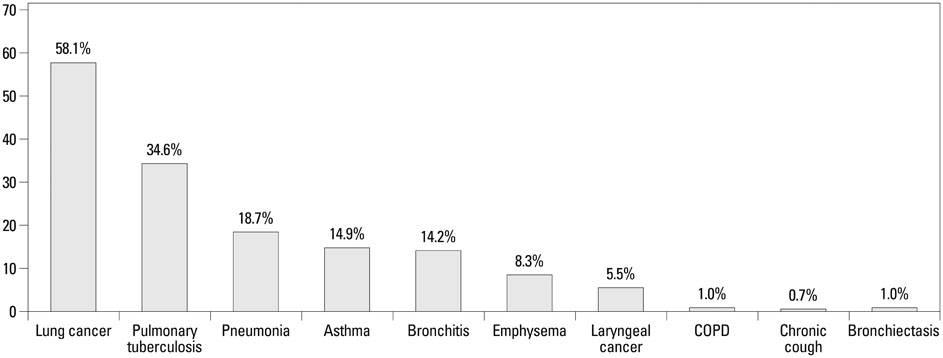Yonsei Med J.
2015 Mar;56(2):362-367. 10.3349/ymj.2015.56.2.362.
Awareness of COPD in a High Risk Korean Population
- Affiliations
-
- 1Division of Pulmonary, Allergy, and Critical Care Medicine, Department of Internal Medicine, Hallym University Sacred Heart Hospital, Anyang, Korea. pulmoks@hallym.ac.kr
- 2Division of Pulmonary, Allergy, and Critical Care Medicine, Department of Internal Medicine, Korea University Guro Hospital, Seoul, Korea.
- KMID: 2070011
- DOI: http://doi.org/10.3349/ymj.2015.56.2.362
Abstract
- PURPOSE
Increased awareness and understanding of chronic obstructive pulmonary disease (COPD) is an important aspect of disease management. The aim of this study was to explore COPD awareness among smokers participating in a smoking cessation program.
MATERIALS AND METHODS
Face-to-face interviews were conducted with 289 subjects in three smoking cessation clinics, using a structured questionnaire.
RESULTS
A total of 68.2% of subjects had COPD-related symptoms, and 19.7% were in poor health. Only 1.0% of the subjects knew that COPD was a respiratory disease. A total of 2.4% of subjects had been diagnosed with COPD and received treatment. Television was the most common source of information about COPD, with 57.1% of the subjects receiving information in this way. After being informed about COPD, smoking-cessation willingness increased in 84.1% of the study group. It increased in 86.3% of the subjects without awareness of COPD and in 81.2% of subjects with COPD-related symptoms.
CONCLUSION
We found that awareness of COPD is very poor among current smokers in Korea. Many smokers perceived their health status as good, despite the presence of COPD-related symptoms. As the level of smoking-cessation willingness was different between those with and without awareness of COPD or COPD-related symptoms, a personalized education program with various educational tools may be needed to enhance awareness of the disease and to motivate smokers to quit.
MeSH Terms
-
Adult
Aged
Aged, 80 and over
Asian Continental Ancestry Group/psychology
*Awareness
Female
*Health Knowledge, Attitudes, Practice
Health Status
Health Surveys
Humans
Interviews as Topic
Male
Middle Aged
Motivation
*Pulmonary Disease, Chronic Obstructive/diagnosis/etiology/prevention & control
Questionnaires
Republic of Korea
Risk Factors
Smoking/*adverse effects/epidemiology
Smoking Cessation
Figure
Reference
-
1. Yoo KH, Kim YS, Sheen SS, Park JH, Hwang YI, Kim SH, et al. Prevalence of chronic obstructive pulmonary disease in Korea: the fourth Korean National Health and Nutrition Examination Survey, 2008. Respirology. 2011; 16:659–665.
Article2. Korean Statistical Information Service (KSIS). The cause of death statistics. Available at: http://kosis.kr/statisticsList/statisticsList_03List.jsp?vwcd=MT_RTITLE&parmTabId=M_03_01#SubCon.3. Kim JH, Kim EK, Park SH, Lee KA, Hwang YI, Kim EJ, et al. Burden of COPD among Family Caregivers. Tuberc Respir Dis. 2010; 69:434–441.
Article4. Health Insurance Review & Assessment Service. 2009. accessed on 2010 June 1. Available at: http://www.hira.or.kr.5. Global Initiative for Chronic Obstructive Pulmonary Disease (GOLD). Global strategy for diagnosis, management, and prevention of COPD. update 2014. Available at: http://www.goldcopd.org/guidelines-global-strategy-for-diagnosis-management.html.6. Sayiner A, Alzaabi A, Obeidat NM, Nejjari C, Beji M, Uzaslan E, et al. Attitudes and beliefs about COPD: data from the BREATHE study. Respir Med. 2012; 106:Suppl 2. S60–S74.
Article7. Soriano JB, Zielinski J, Price D. Screening for and early detection of chronic obstructive pulmonary disease. Lancet. 2009; 374:721–732.
Article8. Hwang YI, Kwon OJ, Kim YW, Kim YS, Park YB, Lee MG, et al. Awareness and Impact of COPD in Korea: An Epidemiologic Insight Survey. Tuberc Respir Dis. 2011; 71:400–407.
Article9. Fromer L. Diagnosing and treating COPD: understanding the challenges and finding solutions. Int J Gen Med. 2011; 4:729–739.10. Soriano JB, Calle M, Montemayor T, Alvarez-Sala JL, Ruiz-Manzano J, Miravitlles M. The general public's knowledge of chronic obstructive pulmonary disease and its determinants: current situation and recent changes. Arch Bronconeumol. 2012; 48:308–315.
Article11. Khdour MR, Hawwa AF, Kidney JC, Smyth BM, McElnay JC. Potential risk factors for medication non-adherence in patients with chronic obstructive pulmonary disease (COPD). Eur J Clin Pharmacol. 2012; 68:1365–1373.
Article12. Jha P, Ramasundarahettige C, Landsman V, Rostron B, Thun M, Anderson RN, et al. 21st-century hazards of smoking and benefits of cessation in the United States. N Engl J Med. 2013; 368:341–350.
Article13. Fiore MC, Baker TB. Clinical practice. Treating smokers in the health care setting. N Engl J Med. 2011; 365:1222–1231.14. Kim HJ, Joh HK, Kwon HK, Do HJ, Oh SW, Lym YL, et al. Concern in and Utilization of the Mass Media Health Information in Community-dwelling Elderly. Korean J Fam Med. 2009; 30:426–439.
Article
- Full Text Links
- Actions
-
Cited
- CITED
-
- Close
- Share
- Similar articles
-
- Implications of Managing Chronic Obstructive Pulmonary Disease in Cardiovascular Diseases
- Prevalence and socioeconomic burden of chronic obstructive pulmonary disease
- Epidemiology of Chronic Obstructive Pulmonary Disease (COPD)
- Risk Factors of Chronic Obstructive Pulmonary Disease (COPD)
- Awareness of chronic obstructive pulmonary disease in current smokers: a nationwide survey



